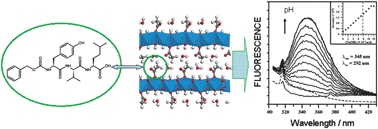Peptide-intercalated layered metal hydroxides: effect of peptide chain length and side chain functionality on structural, optical and magnetic properties†
Abstract
New hybrid materials have been prepared by grafting synthetic

* Corresponding authors
a IPCMS, UMR CNRS-UdS 7504, 23 rue du Loess, BP43, 67034 Strasbourg cedex 2, France
b Functionalized Materials Group, ICMCB-University Bordeaux1, 87, Av. Dr Albert Schweitzer, 33608 PESSAC cedex, France
c University of Potsdam, Institute of Chemistry, Karl-Liebknecht-Straße 24-25, 14476 Golm, Germany
d MPI of Colloids and Interfaces, Am Mühlenberg 1, 14476 Golm, Germany
e BAM, Federal Institute for Materials Research and Testing, Richard-Willstaetter-Str. 1, 12489 Berlin, Germany
New hybrid materials have been prepared by grafting synthetic

 Please wait while we load your content...
Something went wrong. Try again?
Please wait while we load your content...
Something went wrong. Try again?
S. Si, A. Taubert, A. Mantion, G. Rogez and P. Rabu, Chem. Sci., 2012, 3, 1945 DOI: 10.1039/C2SC01087A
To request permission to reproduce material from this article, please go to the Copyright Clearance Center request page.
If you are an author contributing to an RSC publication, you do not need to request permission provided correct acknowledgement is given.
If you are the author of this article, you do not need to request permission to reproduce figures and diagrams provided correct acknowledgement is given. If you want to reproduce the whole article in a third-party publication (excluding your thesis/dissertation for which permission is not required) please go to the Copyright Clearance Center request page.
Read more about how to correctly acknowledge RSC content.
 Fetching data from CrossRef.
Fetching data from CrossRef.
This may take some time to load.
Loading related content
